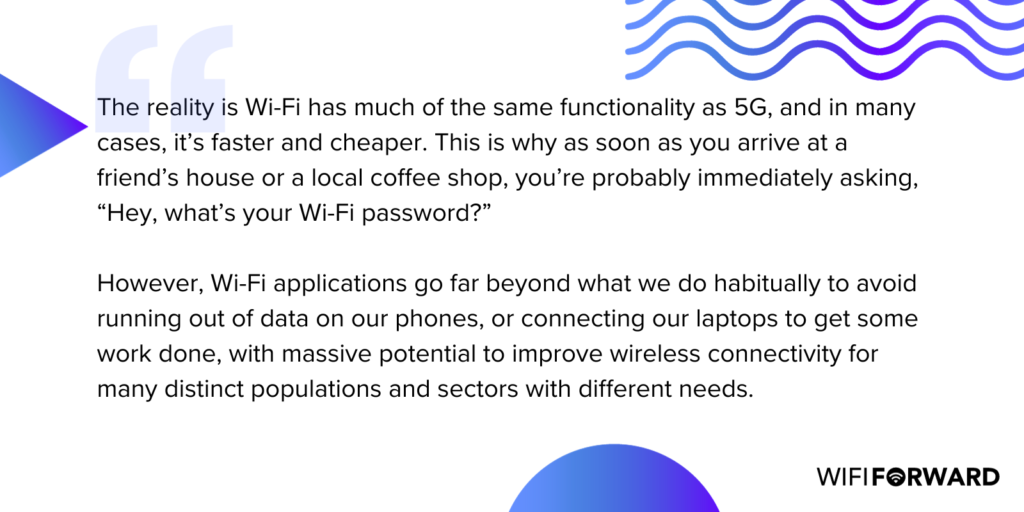These days, we use Wi-Fi for just about everything. Wi-Fi equips us to enjoy the simple pleasures of our day-to-day, from streaming our favorite podcasts and playlists to helping us work at the office or in the comfort of our homes. The mobile industry admits that at least 56% of cellular data is “offloaded” onto Wi-Fi – and we estimate that number to be much higher.
The reality is Wi-Fi has much of the same functionality as 5G, and in many cases, it’s faster and cheaper. This is why as soon as you arrive at a friend’s house or a local coffee shop, you’re probably immediately asking, “Hey, what’s your Wi-Fi password?”
However, Wi-Fi applications go far beyond what we do habitually to avoid running out of data on our phones, or connecting our laptops to get some work done, with massive potential to improve wireless connectivity for many distinct populations and sectors with different needs. Check out some of the creative, ingenious uses we’ve witnessed across industries that demonstrate all that is possible within unlicensed spectrum:

Education
One of Wi-Fi’s latest success stories, lauded by the FCC, is on school buses, connecting K-12 students on their way to and from school. For example, a school district in Alachua County, FL, installed Wi-Fi routers on 125 school buses after winning a grant through the FCC’s Emergency Connectivity Fund. In many school districts across the country, implementing such technologies keeps students connected and encourages them to make use of their ride time, especially in rural areas where they may have to travel farther distances to school.
Health Care
Wi-Fi has become critical for telehealth, especially during the COVID-19 pandemic, but the capabilities go beyond simply video-calling with your doctor if you’re feeling sick. Covenant Health, an integrated health system organization based in Knoxville, TN, is just one example of a provider using Wi-Fi connectivity to improve in-home hospital services. By sharing technology directly with patients, including a Wi-Fi router, tablet and phone, doctors can monitor patients from afar, and those with conditions such as pneumonia, asthma or pulmonary disease can recover at home rather than in a hospital bed. Covenant Health’s medical director noted that they already see improved patient health outcomes and reduced infection and readmission rates in correlation with the rollout of this telemedicine program.
Agriculture
Another sector that you might not realize is rapidly modernizing with the help of Wi-Fi technology is the agricultural industry. Internet of Things (IoT) advancements, such as soil and weather sensors, allow farmers to monitor their crops for the highest yield and to avoid threats posed by climate and pests. Even wearable devices can collect data on animals’ nutrition, movement activity and more, providing valuable insights to farmers on their livestock. These smart devices operating over Wi-Fi and Bluetooth wouldn’t be possible without access to unlicensed spectrum.
Wi-Fi is interwoven into our everyday lives, and it has the potential to do so much more. It’s an essential tool for bridging the digital divide – from farm to table, classrooms to living rooms, and inpatient to outpatient care. WifiForward will continue firmly advocating for unlicensed spectrum so opportunities spurring American innovation and encouraging entrepreneurial problem-solving continue to grow.
